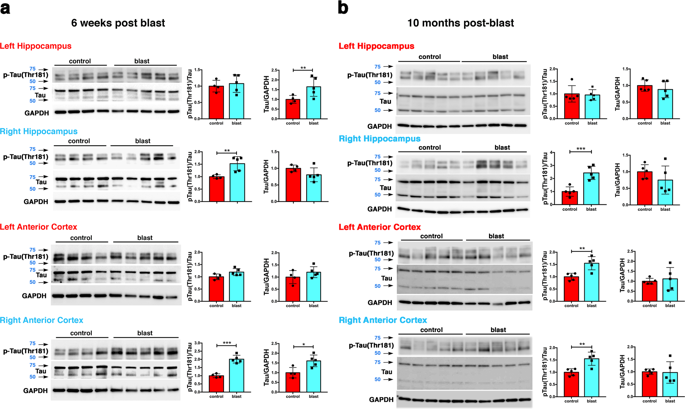当前位置:
X-MOL 学术
›
Mol. Psychiatry
›
论文详情
Our official English website, www.x-mol.net, welcomes your feedback! (Note: you will need to create a separate account there.)
Brain and blood biomarkers of tauopathy and neuronal injury in humans and rats with neurobehavioral syndromes following blast exposure.
Molecular Psychiatry ( IF 11.0 ) Pub Date : 2020-02-25 , DOI: 10.1038/s41380-020-0674-z Dara L Dickstein 1, 2 , Rita De Gasperi 3, 4 , Miguel A Gama Sosa 3, 4 , Georgina Perez-Garcia 3, 5 , Jennifer A Short 4 , Heidi Sosa 3, 4 , Gissel M Perez 3 , Anna E Tschiffely 6 , Kristen Dams-O'Connor 5, 7 , Mariel Y Pullman 4 , Karin Knesaurek 8 , Andrew Knutsen 2 , Dzung L Pham 2 , Lale Soleimani 8 , Barry D Jordan 9 , Wayne A Gordon 7 , Bradley N Delman 8 , Gleb Shumyatsky 10 , Pashtun-Poh Shahim 2, 11 , Steven T DeKosky 12 , James R Stone 13 , Elaine Peskind 14, 15 , Kaj Blennow 16, 17 , Henrik Zetterberg 16, 17, 18, 19 , Steven A Chance 20 , Mario Torso 20 , Lale Kostakoglu 8 , Mary Sano 3, 4, 21 , Patrick R Hof 21, 22, 23 , Stephen T Ahlers 6 , Sam Gandy 3, 4, 5, 21, 24, 25, 26 , Gregory A Elder 4, 5, 21, 25
Molecular Psychiatry ( IF 11.0 ) Pub Date : 2020-02-25 , DOI: 10.1038/s41380-020-0674-z Dara L Dickstein 1, 2 , Rita De Gasperi 3, 4 , Miguel A Gama Sosa 3, 4 , Georgina Perez-Garcia 3, 5 , Jennifer A Short 4 , Heidi Sosa 3, 4 , Gissel M Perez 3 , Anna E Tschiffely 6 , Kristen Dams-O'Connor 5, 7 , Mariel Y Pullman 4 , Karin Knesaurek 8 , Andrew Knutsen 2 , Dzung L Pham 2 , Lale Soleimani 8 , Barry D Jordan 9 , Wayne A Gordon 7 , Bradley N Delman 8 , Gleb Shumyatsky 10 , Pashtun-Poh Shahim 2, 11 , Steven T DeKosky 12 , James R Stone 13 , Elaine Peskind 14, 15 , Kaj Blennow 16, 17 , Henrik Zetterberg 16, 17, 18, 19 , Steven A Chance 20 , Mario Torso 20 , Lale Kostakoglu 8 , Mary Sano 3, 4, 21 , Patrick R Hof 21, 22, 23 , Stephen T Ahlers 6 , Sam Gandy 3, 4, 5, 21, 24, 25, 26 , Gregory A Elder 4, 5, 21, 25
Affiliation

|
Traumatic brain injury (TBI) is a risk factor for the later development of neurodegenerative diseases that may have various underlying pathologies. Chronic traumatic encephalopathy (CTE) in particular is associated with repetitive mild TBI (mTBI) and is characterized pathologically by aggregation of hyperphosphorylated tau into neurofibrillary tangles (NFTs). CTE may be suspected when behavior, cognition, and/or memory deteriorate following repetitive mTBI. Exposure to blast overpressure from improvised explosive devices (IEDs) has been implicated as a potential antecedent for CTE amongst Iraq and Afghanistan Warfighters. In this study, we identified biomarker signatures in rats exposed to repetitive low-level blast that develop chronic anxiety-related traits and in human veterans exposed to IED blasts in theater with behavioral, cognitive, and/or memory complaints. Rats exposed to repetitive low-level blasts accumulated abnormal hyperphosphorylated tau in neuronal perikarya and perivascular astroglial processes. Using positron emission tomography (PET) and the [18F]AV1451 (flortaucipir) tau ligand, we found that five of 10 veterans exhibited excessive retention of [18F]AV1451 at the white/gray matter junction in frontal, parietal, and temporal brain regions, a typical localization of CTE tauopathy. We also observed elevated levels of neurofilament light (NfL) chain protein in the plasma of veterans displaying excess [18F]AV1451 retention. These findings suggest an association linking blast injury, tauopathy, and neuronal injury. Further study is required to determine whether clinical, neuroimaging, and/or fluid biomarker signatures can improve the diagnosis of long-term neuropsychiatric sequelae of mTBI.
中文翻译:

爆炸暴露后患有神经行为综合征的人和大鼠的 tau 病变和神经元损伤的脑和血液生物标志物。
创伤性脑损伤 (TBI) 是后期发展可能具有各种潜在病理的神经退行性疾病的危险因素。慢性创伤性脑病 (CTE) 尤其与重复性轻度 TBI (mTBI) 相关,其病理特征是过度磷酸化的 tau 聚集成神经原纤维缠结 (NFT)。当重复 mTBI 后行为、认知和/或记忆恶化时,可能怀疑 CTE。暴露于简易爆炸装置 (IED) 的爆炸超压已被认为是伊拉克和阿富汗作战人员发生 CTE 的潜在前因。在这项研究中,我们确定了暴露于反复低强度爆炸并发展为慢性焦虑相关特征的大鼠和在剧院中暴露于 IED 爆炸的人类退伍军人的生物标志物特征,这些特征包括行为、认知、和/或内存投诉。暴露于重复低水平爆炸的大鼠在神经元核周和血管周星形胶质细胞过程中积累了异常的过度磷酸化 tau。使用正电子发射断层扫描 (PET) 和 [18F]AV1451 (flortaucipir) tau 配体,我们发现 10 名退伍军人中有 5 名在额叶、顶叶和颞脑区域的白质/灰质交界处表现出过度保留 [18F]AV1451 ,CTE τ蛋白病的典型定位。我们还观察到退伍军人血浆中神经丝光 (NfL) 链蛋白水平升高,显示出过量的 [18F] AV1451 保留。这些发现表明爆炸损伤、tau蛋白病和神经元损伤之间存在关联。需要进一步研究以确定临床、神经影像学、
更新日期:2020-02-25
中文翻译:

爆炸暴露后患有神经行为综合征的人和大鼠的 tau 病变和神经元损伤的脑和血液生物标志物。
创伤性脑损伤 (TBI) 是后期发展可能具有各种潜在病理的神经退行性疾病的危险因素。慢性创伤性脑病 (CTE) 尤其与重复性轻度 TBI (mTBI) 相关,其病理特征是过度磷酸化的 tau 聚集成神经原纤维缠结 (NFT)。当重复 mTBI 后行为、认知和/或记忆恶化时,可能怀疑 CTE。暴露于简易爆炸装置 (IED) 的爆炸超压已被认为是伊拉克和阿富汗作战人员发生 CTE 的潜在前因。在这项研究中,我们确定了暴露于反复低强度爆炸并发展为慢性焦虑相关特征的大鼠和在剧院中暴露于 IED 爆炸的人类退伍军人的生物标志物特征,这些特征包括行为、认知、和/或内存投诉。暴露于重复低水平爆炸的大鼠在神经元核周和血管周星形胶质细胞过程中积累了异常的过度磷酸化 tau。使用正电子发射断层扫描 (PET) 和 [18F]AV1451 (flortaucipir) tau 配体,我们发现 10 名退伍军人中有 5 名在额叶、顶叶和颞脑区域的白质/灰质交界处表现出过度保留 [18F]AV1451 ,CTE τ蛋白病的典型定位。我们还观察到退伍军人血浆中神经丝光 (NfL) 链蛋白水平升高,显示出过量的 [18F] AV1451 保留。这些发现表明爆炸损伤、tau蛋白病和神经元损伤之间存在关联。需要进一步研究以确定临床、神经影像学、



























 京公网安备 11010802027423号
京公网安备 11010802027423号